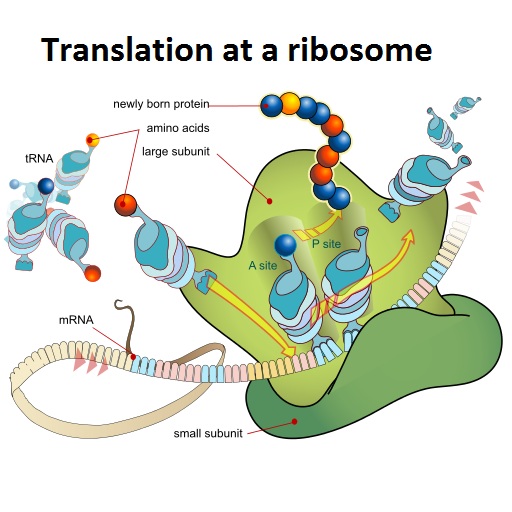Translation & ribosomes
 Students are introduced to the three stages of translation, initiation, synthesis (elongation) and termination. This includes the role of tRNA activating enzymes and the binding sites on ribosomes. There is comparison of free ribosome function and attached ribosomes as well as the roles of polysomes. Visualisations of molecules helps understanding and some short questions conclude the activity.
Students are introduced to the three stages of translation, initiation, synthesis (elongation) and termination. This includes the role of tRNA activating enzymes and the binding sites on ribosomes. There is comparison of free ribosome function and attached ribosomes as well as the roles of polysomes. Visualisations of molecules helps understanding and some short questions conclude the activity.
Lesson Description
Guiding Questions
What happens on a ribosome?
How do binding sites help to assemble all the parts needed for translation?
Did you know that adenine is a DNA base found in tRNA and in ATP?
Activity 1 Three stages of translation
Read this excellent clear entry in the RCSB Protein Data Bank about ribosomes and translation.
Watch this ![]() animation of translation from Alila medical showing the details of translation. Apart from the details of initiation factors at the very beginning the detail is perfect for HL IB students.
animation of translation from Alila medical showing the details of translation. Apart from the details of initiation factors at the very beginning the detail is perfect for HL IB students.
Having read the short article above and seen the animation, or after a teacher explanation of the details of the process of translation, complete the ![]() Three stages of translation student worksheet
Three stages of translation student worksheet
Activity 2: Images and visualisations of Translation
Questions
Questions
- Which is the larger structure tRNA or the ribosome small subunit?
The ribosome small subunit
- How many tRNA molecules can attach to one ribosome at any one time?
Three tRNA molecules, one in each binding site, A,P and E
- Which subunit of the ribosomes catalyses the formation of peptide bonds? (This will be the part which contains the amino acids on each tRNA molecule)
The large subunit
- In which subunit of the ribosome is the mRNA binding site likely to be found? (This will be near the tRNA anticodons.)
The small subunit
Other points about ribosomes
Teachers notes
There are some challenging ideas in this lesson and some students may need a simpler explanation. It is expected that students will have already studied the basic details of translation in the SL topic 2. Translation of mRNA into Amino Acids
Activity 1 An reading task and then a short video are followed by a worksheet of structured note taking and then some IB style questions.
Model answers are available here: Three stages of translation - model answers
Activity 2 An interview with the Nobel prise winner is followed by some short questions and use of online molecule visualisations. It is also possible to Build a paper model of tRNA - using a template and instructions from RCSB.
Activity 3 (in planning) This last activity will look at conserved sequences and how they help biologists to identify important points in the genome which help us to understand the function of genes.
This animation from the DNA Leaning centre is useful to illustrate the speed of the process and the relative sizes of the molecules. ![]() Translation (advanced).
Translation (advanced).
If you'd like to attend a lecture from MIT about this very topic ... ![]() MIT lecture on translation by Eric Lander .
MIT lecture on translation by Eric Lander .
This is an excellent short explanation of Amino acid activation - attaching them to tRNA from the Nobel Prize website.
There is even a colouring book of molecular machines from PDB here.
Alternative activity
I made this animated discussion in about ten minutes using a service called 'Go animate'. Students were then asked to created their own discussions about a detail of the process of translation. The learning takes place when students have to write the script, and type it into the online form. Alternatives to GoAnimate for this activity could be Powtoon, or Animaker.
Like it? Create your own at GoAnimate.com. or www.powtoon.com
Wikimedia Translation Gif
This animated gif is simple, yet it teaches us a lot. I love the second part with the ribosome attached to a membrane as it would be in rER. This would make an excellent audio homework, where students had to study the animation and then record an audio commentary of what is happening. The file was Media of the day in Nov 2020 uploaded by Bensaccount at en.wikipedia CC BY 3.0

 IB Docs (2) Team
IB Docs (2) Team


